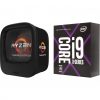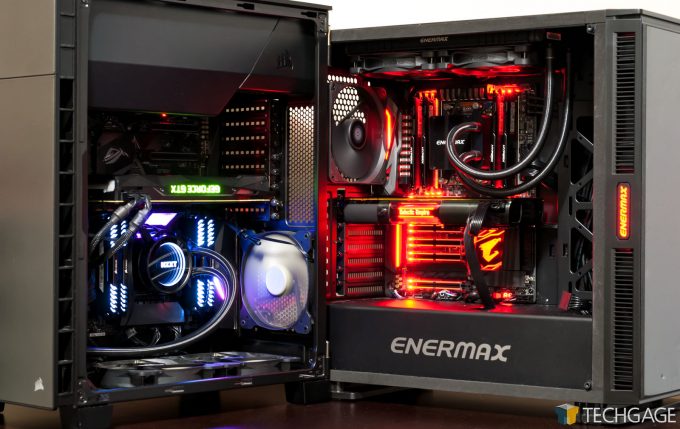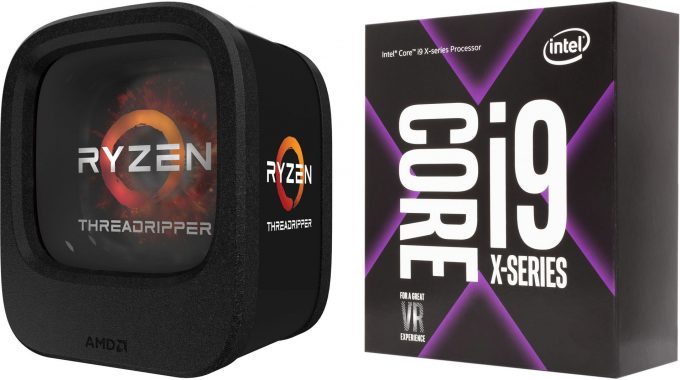- Qualcomm Launches Snapdragon 4 Gen 2 Mobile Platform
- AMD Launches Ryzen PRO 7000 Series Mobile & Desktop Platform
- Intel Launches Sleek Single-Slot Arc Pro A60 Workstation Graphics Card
- NVIDIA Announces Latest Ada Lovelace Additions: GeForce RTX 4060 Ti & RTX 4060
- Maxon Redshift With AMD Radeon GPU Rendering Support Now Available
Battle of the 16-cores: Intel’s Core i9-7960X vs. AMD’s Threadripper 1950X

It still feels a little hard to believe, but both AMD and Intel offer the enthusiast market their own take on a 16-core chip. Remember when quad-cores seemed overkill for desktops? At the top-end, the CPU you choose can greatly affect your workload for better or for worse. So, let’s see what these beefy chips are made of.
Page 1 – Battle Of The 16-core Enthusiast CPUs
I feel like I’m not very good at choosing the best time to post content. After completing a huge round of benchmarking on six processors, news hit the web of a massive security hole found in many processors, and at the current time, it seems Intel’s the most affected party.
Currently, it’s expected that a security patch will reduce the performance in some workloads, though how much degradation will occur is yet to be seen. It originally felt like performance could be severely impacted, but initial tests conducted by other outlets around the world haven’t really given much reason for concern (although it does seem like it’s largely I/O-intensive workloads that will be affected).
If it’s discovered that this patch notably decreases performance (as in, it impacts the benchmarks), I’ll revisit testing. At this point, I don’t expect the results in this review to greatly change, though if you want to remain cautious, you’d get no sneer from me.
Bad timing aside, this article was a fun one to produce, because… how couldn’t benchmarking 16-core chips be enjoyable? With its Core X series, Intel one-upped AMD by adding 2 cores to its top-end model, so for that reason, I wanted to focus this article more around the chips equal in cores and threads.
The article could also be read from the stand-point of comparing two $999 chips: 1950X and i9-7900X. With 6 cores and 12 threads over Intel in that match-up, don’t be surprised to see impressive gains from AMD in some tests. Currently, AMD offers some excellent value with its Threadripper chips, but Intel remains firm with its pricing thanks to its proven performance, and platform dominance. Zen 2 will undoubtedly be interesting to watch for, because it could really shake things up. If this whole security thing doesn’t manage to, that is.
A Look At What AMD & Intel Offer
AMD and Intel are targeting the same crowd with their respective lineups here. If you’re more of a mainstream user, one who doesn’t want to splurge upwards of $2,000 for a CPU, GPU, and motherboard, you’ll want to look towards AMD’s Ryzen, and Intel’s 8th-gen Core. For enthusiasts – those who demand the best out of their rig – there’s Threadripper, and Core X.
The current Threadripper lineup is pretty simple, carrying a mere three SKUs. Considering the fact that EPYC boasts a 32-core model, it seems obvious that AMD could release a 32-core Threadripper if it wanted to, but that would likely eat more into its enterprise margins than deliver on the desktop margins, because based on all of Ryzen up to this point, AMD doesn’t want to rip you off.
| AMD Ryzen Threadripper CPUs | |||||||
| Clock | Turbo | Cores | Cache | Memory | Power | Price | |
| 1950X | 3.4 GHz | 4.0 GHz | 16 (32T) | 8+32MB | Quad | 180W | $999 |
| 1920X | 3.5 GHz | 4.0 GHz | 12 (24T) | 8+32MB | Quad | 180W | $799 |
| 1900X | 3.8 GHz | 4.0 GHz | 8 (16T) | 4+16MB | Quad | 180W | $549 |
Another highlight of Threadripper is that it boasts an industry-leading number of PCIe lanes – 64 on the chip – although I don’t personally treat that as something overly important. I haven’t yet seen a real-world example where so many lanes are needed, but if they are, you’re going to be the most hardcore of the hardcore type of user. Even so, it’s appreciated that AMD took one thing we used to be limited on, and gave us more than we’ll ever need (don’t quote me).
Intel’s Core X lineup is grander than AMD’s, but it has a much wider price gap to cover. SRP for SRP, Intel is only offering a 10-core chip to go against AMD’s 16-core, and as the benchmark results will show, the underdog is fierce in that match-up. AMD isn’t touching any of Intel’s top models, though, and as the benchmark results will also show, even when Threadripper should technically dominate, Intel can still burst ahead.
| Intel Core X-Series CPUs | |||||||
| Clock | Turbo | Cores | Cache | Memory | Power | Price | |
| i9-7980XE | 2.6 GHz | 4.2 GHz | 18 (36T) | 24.75MB | Quad | 165W | $1,999 |
| i9-7960X | 2.8 GHz | 4.2 GHz | 16 (32T) | 22MB | Quad | 165W | $1,699 |
| i9-7940X | 3.1 GHz | 4.3 GHz | 14 (28T) | 19.25MB | Quad | 165W | $1,399 |
| i9-7920X | 2.9 GHz | 4.3 GHz | 12 (24T) | 16.5MB | Quad | 140W | $1,199 |
| i9-7900X | 3.3 GHz | 4.3 GHz | 10 (20T) | 13.75MB | Quad | 140W | $999 |
| i7-7820X | 3.6 GHz | 4.3 GHz | 8 (16T) | 11MB | Quad | 140W | $599 |
| i7-7800X | 3.5 GHz | 4.0 GHz | 6 (12T) | 8.25MB | Quad | 140W | $389 |
| i7-7740X | 4.3 GHz | 4.5 GHz | 4 (8T) | 8MB | Dual | 112W | $339 |
| i5-7640X | 4.0 GHz | 4.2 GHz | 4 (4T) | 6MB | Dual | 112W | $242 |
I have to reiterate how bizarre some of the bottom models in this lineup are. The two SKUs at the bottom of the Core X line directly overlap with certain Coffee Lake chips, and in my mind, I wouldn’t choose a Kaby Lake 4-core 7740X at $325 over a Coffee Lake 6-core 8700K at $389. The X299 platform is more expensive than Z370, so you’d need a really good reason to want to go quad-core (and dual-channel) on a platform like this.
I digress. In some match-ups, Intel is very competitive, but at the top-end, AMD makes its pricing look a little extreme. But, to be fair, “X” does in fact imply “extreme”.
If you’ve been following the CPU space since Ryzen launched, you probably already know the conclusion to this story (and if so, cheers for pressing on anyway). Intel still dominates overall, with its strong IPC and residual optimizations from being the performance leader the past decade. Meanwhile, AMD competes hard on price, knowing that it can’t win every match-up.
Where 16-cores are concerned, I’m glad they exist at all. I truly didn’t anticipate benchmarking a 16-core from both AMD and Intel at this point. We went from 10 cores after 8-cores had been available for a while, and all of a sudden, we have 16 and even 18-core chips available.
The last time I felt this excited about benchmarking CPUs was with Intel’s Skulltrail platform, which brought 8 cores to enthusiasts with the help of a dual-socket system. Trying to exercise all of those cores was a challenge, but a fun one. I felt a bit of nostalgia as I sought out to find benchmarks to take advantage of the gargantuan 18-core.
Ahem, enough of that. If you’re curious about the methodologies used for testing, and the PCs used, head to the next page. Otherwise, jump to page 3 to get on with the benchmarks.
Support our efforts! With ad revenue at an all-time low for written websites, we're relying more than ever on reader support to help us continue putting so much effort into this type of content. You can support us by becoming a Patron, or by using our Amazon shopping affiliate links listed through our articles. Thanks for your support!







